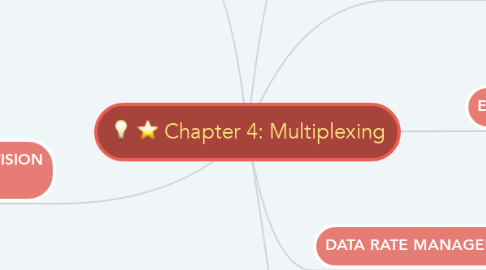Chapter 4: Multiplexing
por nurul syazwanie


1. FREQUENCY-DIVISION MULTIPLEXING
1.1. the bandwidth of a link (Hz) is greater than the combined bandwidths of the signals
1.2. Analog
1.3. combines analog signals become one composite signal.
1.4. separated by strips of unused bandwidth (guard bands) to prevent signals from overlapping.
2. WAVELENGTH-DIVISION MULTIPLEXING
2.1. Analog
2.2. the multiplexing and demultiplexing involve optical signals
2.3. light are multiplexed and demultiplexed by using a prism.
2.4. multiplex a very large number of channels by spacing channels closer to one another
3. TIME-DIVISION MULTIPLEXING
3.1. SYNCHRONOUS TDM
3.1.1. each input occupies one time slot and occupies one output time slot.
3.1.2. grouped into frames
3.2. STATISTICAL TIME-DIVISION MULTIPLEXING
3.2.1. slots are dynamically allocated
3.2.2. the number slots in each frame is less than the number of input lines.
4. Definition:
4.1. A set of techniques that allows the transmission of multiple signals across a single data link
5. TYPES OF MULTIPLEXING
5.1. FREQUENCY-DIVISION MULTIPLEXING
5.2. WAVELENGTH-DIVISION MULTIPLEXING
5.3. TIME -DIVISION MULTIPLEXING
6. EMPTY SLOTS
6.1. one of the input lines has no data to send
7. DATA RATE MANAGEMENT
7.1. to handle a disparity
7.2. i. Multilevel Multiplexing
7.2.1. data rate of an input line is a multiple of others.
7.3. ii.Multiple-Slot Allocation
7.3.1. to allot more than one slot in a frame to a single input line. Figure
7.4. iii.Pulse Stuffing
7.4.1. bit rates of sources are not multiple integers of each other.

